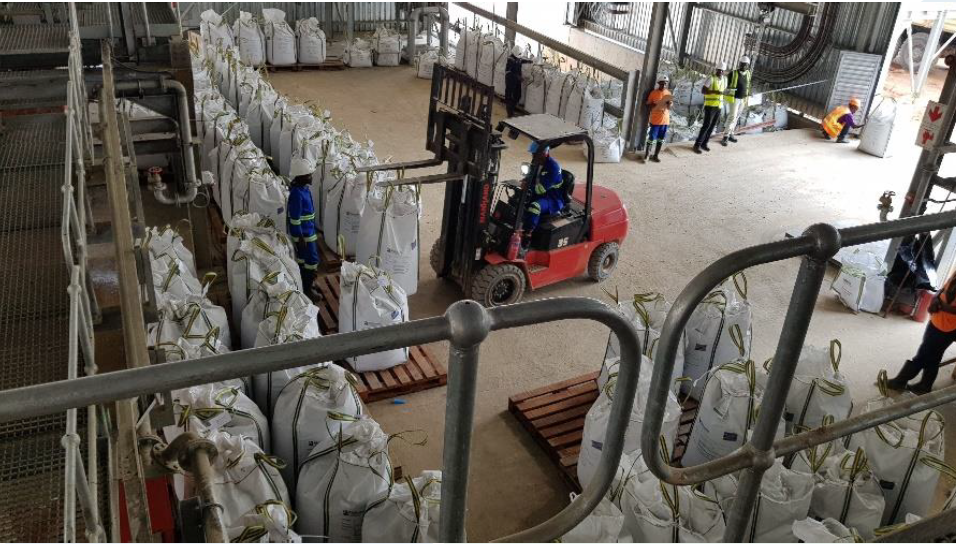Covid-19 is actually assisting the African tin producer Alphamin Resources (TSXV:AFM) (JSE: APH)
Located in the remote eastern parts of the Democratic Republic of the Congo (DRC), the pandemic has hardly affected operations at Alphamin’s mine in the North Kivu province. Although several workers were stranded in South Africa for a few weeks during the hard lockdown in March earlier this year, the impact was negligible, and in fact, production increased during that quarter, while Alphamin continued stockpiling its high-grade tin. At the same time, borders in East Africa remained open and Alphamin was able to keep its off-take partners happy with a steady supply of tin concentrate from the Mpama-North deposit at Bisie Hill.
Tin mines under pressure
While mines around the world dithered in the face of the Covid-19 outfall, Alphamin steadied the ship, and continued churning out some of the highest-grade tin concentrate in the world. Its solid reliability and high-quality product have earned it a spot as the second largest producer outside of China and Indonesia. Moreover, as supply from several traditional markets dry up in a second wave of the Covid-19 blues, and China’s thirst for tin gradually increases in an early pessimistic post-pandemic recovery, Alphamin is sitting pretty in its far-flung corner of the Congo Basin.
It gets rosier for Alphamin though. In a confused, pandemic induced world, where tin is predicted to play an increasingly important role, the hunt for high grade tin deposits is on, with China and the USA leading from the front. With several traditional markets in the doldrums, for more reasons than just the Coronavirus, Alphamin has, in a way, become the kingpin in a chess game.
While world supply is dwindling, the USA has declared tin a strategic mineral, and China is expected to do the same. Recycled tin forms the bulk of the current supply in the American market. Although the government is encouraging exploration, there is not one active tin mine in America. Under normal circumstances, local product and other Asian supply would be enough to satisfy Chinese demand, but these are extraordinary times, and with several mines in China, Myanmar and South America paralysed by Covid-19, African and Australian tin operations have suddenly become more than just mouth-watering prospects for the perpetually ambitious Chinese. Alphamin’s prime tin product has been on the Chinese shopping list for a long time, and rumour has it that the company is also selling tin concentrate to a large Chinese smelter.
China will decide next year whether or not tin will be included in its stockpiling programme for strategic commodities, but given the country’s existing manufacturing base and enthusiasm to innovate and develop new technology, it is highly likely that the metal will be on the “strategic” list.
Large deficits looming
In the face of a growing supply deficit and a renewed appetite for tin, the metal’s price has slowly crept up to levels extremely amenable for quality mines like Alphamin. At the time of writing tin was selling at USD18,300 per tonne on the London Metal Exchange (LME). That is an increase of almost 6.5% from the beginning of 2020 and nudging against September’s one-year high of USD18,510. According to analysts at Macquarie Bank, there is enough reason to adjust their supply-demand balance to account for some stocking this year and next.
They postulate about 5,000 tonnes of Chinese purchases, split across this year and next and forecast 2020 and 2021 supply deficits deepening to 4,400 tonnes and 2,900 tonnes, respectively. Macquarie is forecasting consecutive years of supply deficit until at least 2025.
Historically, China has been the world’s largest producer and consumer of tin, but in recent years the country has increasingly become reliant on imports from especially tin mines in the Wa area of Myanmar. However, those easily accessible reserves have now either been depleted, or have been rendered inaccessible by above average rainfall and floods, or the mines were not able to get their product across the Chinese border because of Covid-19 lockdowns and travel restrictions. The Covid-19 pandemic has exposed China’s unhealthy reliance on its neighbours’ tin supply. With borders being forced to shut during the worst of the outbreak, China’s tin stockpiles have been depleting at an alarming rate which means smelter margins are squeezed without a steady supply of raw material.
Tin supply dwindles
According to the International Tin Association (ITA) the recovery in tin demand has been strong and industrial production in China is now back to pre-Covid levels. However, the smelters might remain partially barren for the next couple of months as exports from Myanmar trickles through the Chinese border at deflated rates. With more than half of Myanmar’s mines flooded, only 1,900 tonnes of tin-in-concentrate were imported into China in August, down 45% month on month and 36% year on year. According to ITA the issues in Myanmar are expected to persist throughout September and October, which could put pressure on raw materials supply in China. “This, in turn, is likely to see increasing imports of refined tin or a draw-down of stocks on the Shanghai Futures Exchange. Stocks held in Shanghai have already begun falling, with warranted stocks falling by over 20% in the last two weeks,” the ITA stated in a recent report.
It is not only tin mines in Myanmar that have been affected by Covid-19 though. The pandemic has severely disrupted tin mining and smelting during the first quarter of 2020 in Bolivia, for example. The bulk of Bolivian tin is exported to Europe and the United States (40%) and with a second wave of Covid-19 forcing these countries into more strict lockdowns towards the end 2020, the rest of the year might look even worse for Bolivian tin producers.
Mining in Bolivia is conducted by two mines owned by the state mining organisation COMIBOL, as well as several smaller mines and cooperatives. The state-owned Huanuni and Colquiri mines produced about 3,366 tonnes of tin concentrate during the first quarter of 2020, while the rest churned out a combined 2,489 tonnes (total of 5,855 tonnes), 30% less than what the country produced last year over the same period. During the peak of Coronavirus restrictions in the country, total refined tin production in Bolivia was 1,321 tonnes. This was a decline of nearly 66% quarter-on-quarter and 69% year on year. Weak demand and lower production in the first half of 2020 saw exports of refined tin from Bolivia fall some 31.7%. It is estimated that mine closures in Bolivia removed more than 900 tonnes of tin concentrate from the market.
Alphamin shows no lockdown blues
On the other hand, Alphamin’s Bisie improved tin sales in the third quarter of 2020 by more than 3%. Although production at Bisie fell slightly due to lower average tin grades, the company is well on its way to achieve its 2020 target of 10,000 tonnes of tin-in-concentrate. Plant recoveries during the quarter were up from 69% to 71% and throughput increased from 91,928 tonnes to 96,086 tonnes. Although tin production at 2,563 tonnes was 6% lower quarter-on-quarter, Alphamin believes that production will pick up again in the fourth quarter and the company is targeting between 2,600 to 2,800 tonnes of tin-in-concentrate during the last quarter of 2020. Alphamin’s two-year objective is to reach an output of 12,000 tonnes of contained tin per annum, which is well within its capabilities.
Alphamin’s Bisie improved tin sales in the third quarter of 2020 by more than 3%.
Importantly, Alphamin is also focused on delineating additional tin containing orebodies with a view to producing at least 55 of the world’s tin over many decades to come. There is little doubt that the current producing Mpama North orebody extends at depth, there then is the adjacent Mpama South orebody and several other highly prospective areas nearby.
Exploration drilling at Mpama South is imminent and all expectations are that this is likely Alphamin’s second orebody, only a stone’s throw South of the current producing mine.
Alphamin has appointed T3 Drilling SARL, an internationally recognised drilling contractor, to undertake a 6,000m diamond core drilling program at its Mpama South prospect. Mpama South is one kilometre south of the main processing plant at Bisie and the drilling program has been designed to delineate a maiden Mineral Resource at Mpama South.
Between 2012 and 2013, Alphamin drilled 19 drill holes for 3,364m to determine the extent and nature of the mineralisation at Mpama South. Two distinct mineralised zones were intercepted, an upper zone showing well-developed lead, zinc and silver mineralisation, and a lower zone rich in tin and copper. Alphamin has identified several areas along the Bisie Ridge showing soil geochemistry anomalies similar to those found at Mpama North and aims to generate a further 3-5 drill targets from these anomalies over the next 18-months. Additionally, plans are being developed for deep level drilling at the producing Mpama North orebody which is currently open at depth. At a time when the world is in turmoil, Alphamin has been steady, and with demand for tin expected to increase threefold over the next few years, Alphamin is probably one of the safer bets in the tin mining space.









